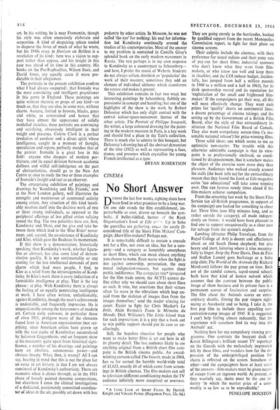Ironside
ART
In Ironside's painting, as well as in the stan- dards embodied in his writing, we do not get much further than the eighteenth century, though a modern awareness gave a special edge to his work. Evolution in time, among artists, is a blessedly untidy affair: witness the faithfulness to the Edwardian period shown by Miss Comp- ton-Burnett or the similar period, hermetically sealed, projected in Lowry's paintings. In Iron- side's painting, we find that decorative eighteenth- century flair which characterises the work of Berman, disturbed in a similar manner by the less amiable teachings of modern psychology. There are also allegiances to German romantic art. In his writing, he is near Fromentin, though his style was often excessively elaborate and serpentine. A kind of despairing spleen tended to disperse the force of much of what he wrote, but his 1940s essay in Horizon on Balthus is a revelation of its kind : here was a vision to sup- port rather than oppose, and his insight in this case was ahead of its time in this country. His books on the Pre-Raphaelites, Wilson Steer, and David Jones, are equally acute if more pre- dictable in their allegiances.
The portraits in the present exhibition confirm what I had always suspected: that Ironside was the most convincing and intelligent practitioner in this genre in England. These paintings are quite without rhetoric or props of any kind—so much so, that they are also, in some way, without charm. Austere, limited to browns, blacks, greys and white, so constrained and honest that they have almost the appearance of solidly modelled sketches, these portraits are convincing and satisfying, obsessively intelligent in their weight and presence. Colette Clark is a perfect revelation of candour and a direct spirit whose intelligence, caught in a moment of thought, speculation and repose, perfectly matches that of the painter. Ironside is a great loss in this field : anyone who despairs of modern por- traiture, and its equal division between academic dullness and wilful self-indulgence on the part of abstractionists, should go to the New Art Centre at once to study the two or three examples of Ironside's insight and tact as an observer.
The enterprising exhibition of paintings and drawings by 'Kandinsky and His Friends,' now at the New London gallery, well illustrates the strengths and weaknesses of communal activity among artists. Any situation of this kind inevit- ably resolves itself into the decisive work of two or three strong individuals, as opposed to the peripheral offerings of less gifted artists rallying round the flag. The two polarities here are, first, Kandinsky and Marc, and the give and take be- tween them which lead to the 'Blue Rider' move- ment, and, second, the co-existence of Kandinsky and Klee, which gave the Bauhaus its momentum.
If this show is a demonstration, historically speaking, then Kandinsky's work, whether figura- tive or abstract, has also some kind of demon- strative quality. It is not sentimentality or any craving for the less intellectual demands of pure charm which lead most people, I find, to Klee as a relief from the intransigencies of Kand- irisky. In Klee's work there is every indication of a formidable intelligence at play. That is the key phrase: at play. With Kandinsky there is always the feeling of an equally penetrating intelligence at work. I have often written, unfashionably, against Kandinsky, though the man's achievement is undeniable, and frequently impressive. He is unquestionably among the forerunners of modern art. Certain early canvases, in particular those of circa 1911, prefigure many of the elements found later in American expressionism (not sur- prising, since American artists have grown up with the vast cache of Kandinskys accumulated by Solomon Guggenheim, and on frequent show at his museum); quite apart from historical signi- ficance, a number of his drawings and paintings have an absolute, autonomous power—and obvious beauty. What, then, is wrong? All I can say, bearing in mind that this is not the place for an essay in art history, is that I am not always convinced of Kandinsky's authenticity. There are moments when it shines through, as in the 1911 phase of loosely painted dynamic compositions, but elsewhere I sense the clinical investigations of a dedicated, passionately committed coordina- tor of ideas in the air, possibly set down with less
pedantry by other artists. In Moscow, he was not called 'the eye' for nothing; his zeal for infornia- lion led Kandinsky continually around the studios of his contemporaries. Most of the answer to my problem is contained in Camilla Gray's splendid book on the early modern movement in Russia. The rest perhaps is in my own response to Kandinsky as a counterpart to Schoenberg— and here, I prefer the music of Webern. Students do not always soften, diminish or 'popularise' the work of their masters; sometimes they add an element of individual alchemy which transforms the source and makes it greater.
This exhibition contains in fact two weak but interesting paintings by Schoenberg, flabbily ex- pressionist in concept and handling; but one of the highlights of the show is the work by Robert Delaunay which has only slight contact with the central colour-space-movement themes of the other artists. The Portrait of Philippe Soupault, the writer, a large coloured drawing for the paint- ing in the modern museum in Paris, is a key work and should find a place in the Tate's collection. There is much else to admire in this bouquet, but Delaunay's drawing has all the abstract dynamism of the time (1922) as well as representing a face, stance, and presence which crystallise the young French intellectual as a type.
BRYAN ROBERTSON































 Previous page
Previous page